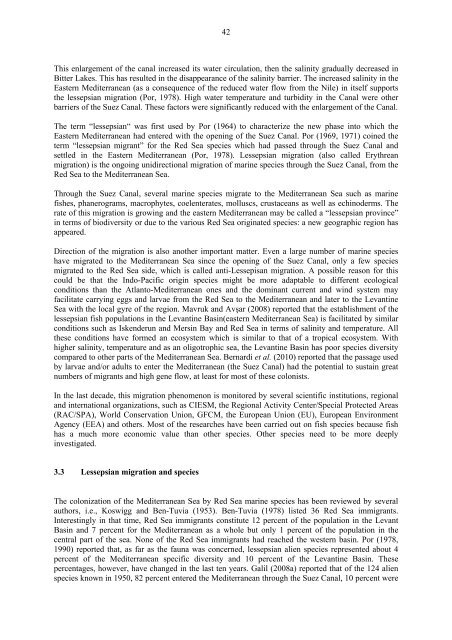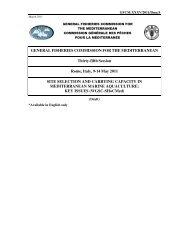Status of alien species in the Mediterranean and Black Sea
Status of alien species in the Mediterranean and Black Sea
Status of alien species in the Mediterranean and Black Sea
You also want an ePaper? Increase the reach of your titles
YUMPU automatically turns print PDFs into web optimized ePapers that Google loves.
42<br />
This enlargement <strong>of</strong> <strong>the</strong> canal <strong>in</strong>creased its water circulation, <strong>the</strong>n <strong>the</strong> sal<strong>in</strong>ity gradually decreased <strong>in</strong><br />
Bitter Lakes. This has resulted <strong>in</strong> <strong>the</strong> disappearance <strong>of</strong> <strong>the</strong> sal<strong>in</strong>ity barrier. The <strong>in</strong>creased sal<strong>in</strong>ity <strong>in</strong> <strong>the</strong><br />
Eastern <strong>Mediterranean</strong> (as a consequence <strong>of</strong> <strong>the</strong> reduced water flow from <strong>the</strong> Nile) <strong>in</strong> itself supports<br />
<strong>the</strong> lessepsian migration (Por, 1978). High water temperature <strong>and</strong> turbidity <strong>in</strong> <strong>the</strong> Canal were o<strong>the</strong>r<br />
barriers <strong>of</strong> <strong>the</strong> Suez Canal. These factors were significantly reduced with <strong>the</strong> enlargement <strong>of</strong> <strong>the</strong> Canal.<br />
The term “lessepsian“ was first used by Por (1964) to characterize <strong>the</strong> new phase <strong>in</strong>to which <strong>the</strong><br />
Eastern <strong>Mediterranean</strong> had entered with <strong>the</strong> open<strong>in</strong>g <strong>of</strong> <strong>the</strong> Suez Canal. Por (1969, 1971) co<strong>in</strong>ed <strong>the</strong><br />
term “lessepsian migrant” for <strong>the</strong> Red <strong>Sea</strong> <strong>species</strong> which had passed through <strong>the</strong> Suez Canal <strong>and</strong><br />
settled <strong>in</strong> <strong>the</strong> Eastern <strong>Mediterranean</strong> (Por, 1978). Lessepsian migration (also called Erythrean<br />
migration) is <strong>the</strong> ongo<strong>in</strong>g unidirectional migration <strong>of</strong> mar<strong>in</strong>e <strong>species</strong> through <strong>the</strong> Suez Canal, from <strong>the</strong><br />
Red <strong>Sea</strong> to <strong>the</strong> <strong>Mediterranean</strong> <strong>Sea</strong>.<br />
Through <strong>the</strong> Suez Canal, several mar<strong>in</strong>e <strong>species</strong> migrate to <strong>the</strong> <strong>Mediterranean</strong> <strong>Sea</strong> such as mar<strong>in</strong>e<br />
fishes, phanerograms, macrophytes, coelenterates, molluscs, crustaceans as well as ech<strong>in</strong>oderms. The<br />
rate <strong>of</strong> this migration is grow<strong>in</strong>g <strong>and</strong> <strong>the</strong> eastern <strong>Mediterranean</strong> may be called a “lessepsian prov<strong>in</strong>ce”<br />
<strong>in</strong> terms <strong>of</strong> biodiversity or due to <strong>the</strong> various Red <strong>Sea</strong> orig<strong>in</strong>ated <strong>species</strong>: a new geographic region has<br />
appeared.<br />
Direction <strong>of</strong> <strong>the</strong> migration is also ano<strong>the</strong>r important matter. Even a large number <strong>of</strong> mar<strong>in</strong>e <strong>species</strong><br />
have migrated to <strong>the</strong> <strong>Mediterranean</strong> <strong>Sea</strong> s<strong>in</strong>ce <strong>the</strong> open<strong>in</strong>g <strong>of</strong> <strong>the</strong> Suez Canal, only a few <strong>species</strong><br />
migrated to <strong>the</strong> Red <strong>Sea</strong> side, which is called anti-Lessepisan migration. A possible reason for this<br />
could be that <strong>the</strong> Indo-Pacific orig<strong>in</strong> <strong>species</strong> might be more adaptable to different ecological<br />
conditions than <strong>the</strong> Atlanto-<strong>Mediterranean</strong> ones <strong>and</strong> <strong>the</strong> dom<strong>in</strong>ant current <strong>and</strong> w<strong>in</strong>d system may<br />
facilitate carry<strong>in</strong>g eggs <strong>and</strong> larvae from <strong>the</strong> Red <strong>Sea</strong> to <strong>the</strong> <strong>Mediterranean</strong> <strong>and</strong> later to <strong>the</strong> Levant<strong>in</strong>e<br />
<strong>Sea</strong> with <strong>the</strong> local gyre <strong>of</strong> <strong>the</strong> region. Mavruk <strong>and</strong> Avşar (2008) reported that <strong>the</strong> establishment <strong>of</strong> <strong>the</strong><br />
lessepsian fish populations <strong>in</strong> <strong>the</strong> Levant<strong>in</strong>e Bas<strong>in</strong>(eastern <strong>Mediterranean</strong> <strong>Sea</strong>) is facilitated by similar<br />
conditions such as Iskenderun <strong>and</strong> Mers<strong>in</strong> Bay <strong>and</strong> Red <strong>Sea</strong> <strong>in</strong> terms <strong>of</strong> sal<strong>in</strong>ity <strong>and</strong> temperature. All<br />
<strong>the</strong>se conditions have formed an ecosystem which is similar to that <strong>of</strong> a tropical ecosystem. With<br />
higher sal<strong>in</strong>ity, temperature <strong>and</strong> as an oligotrophic sea, <strong>the</strong> Levant<strong>in</strong>e Bas<strong>in</strong> has poor <strong>species</strong> diversity<br />
compared to o<strong>the</strong>r parts <strong>of</strong> <strong>the</strong> <strong>Mediterranean</strong> <strong>Sea</strong>. Bernardi et al. (2010) reported that <strong>the</strong> passage used<br />
by larvae <strong>and</strong>/or adults to enter <strong>the</strong> <strong>Mediterranean</strong> (<strong>the</strong> Suez Canal) had <strong>the</strong> potential to susta<strong>in</strong> great<br />
numbers <strong>of</strong> migrants <strong>and</strong> high gene flow, at least for most <strong>of</strong> <strong>the</strong>se colonists.<br />
In <strong>the</strong> last decade, this migration phenomenon is monitored by several scientific <strong>in</strong>stitutions, regional<br />
<strong>and</strong> <strong>in</strong>ternational organizations, such as CIESM, <strong>the</strong> Regional Activity Center/Special Protected Areas<br />
(RAC/SPA), World Conservation Union, GFCM, <strong>the</strong> European Union (EU), European Environment<br />
Agency (EEA) <strong>and</strong> o<strong>the</strong>rs. Most <strong>of</strong> <strong>the</strong> researches have been carried out on fish <strong>species</strong> because fish<br />
has a much more economic value than o<strong>the</strong>r <strong>species</strong>. O<strong>the</strong>r <strong>species</strong> need to be more deeply<br />
<strong>in</strong>vestigated.<br />
3.3 Lessepsian migration <strong>and</strong> <strong>species</strong><br />
The colonization <strong>of</strong> <strong>the</strong> <strong>Mediterranean</strong> <strong>Sea</strong> by Red <strong>Sea</strong> mar<strong>in</strong>e <strong>species</strong> has been reviewed by several<br />
authors, i.e., Koswigg <strong>and</strong> Ben-Tuvia (1953). Ben-Tuvia (1978) listed 36 Red <strong>Sea</strong> immigrants.<br />
Interest<strong>in</strong>gly <strong>in</strong> that time, Red <strong>Sea</strong> immigrants constitute 12 percent <strong>of</strong> <strong>the</strong> population <strong>in</strong> <strong>the</strong> Levant<br />
Bas<strong>in</strong> <strong>and</strong> 7 percent for <strong>the</strong> <strong>Mediterranean</strong> as a whole but only 1 percent <strong>of</strong> <strong>the</strong> population <strong>in</strong> <strong>the</strong><br />
central part <strong>of</strong> <strong>the</strong> sea. None <strong>of</strong> <strong>the</strong> Red <strong>Sea</strong> immigrants had reached <strong>the</strong> western bas<strong>in</strong>. Por (1978,<br />
1990) reported that, as far as <strong>the</strong> fauna was concerned, lessepsian <strong>alien</strong> <strong>species</strong> represented about 4<br />
percent <strong>of</strong> <strong>the</strong> <strong>Mediterranean</strong> specific diversity <strong>and</strong> 10 percent <strong>of</strong> <strong>the</strong> Levant<strong>in</strong>e Bas<strong>in</strong>. These<br />
percentages, however, have changed <strong>in</strong> <strong>the</strong> last ten years. Galil (2008a) reported that <strong>of</strong> <strong>the</strong> 124 <strong>alien</strong><br />
<strong>species</strong> known <strong>in</strong> 1950, 82 percent entered <strong>the</strong> <strong>Mediterranean</strong> through <strong>the</strong> Suez Canal, 10 percent were
















